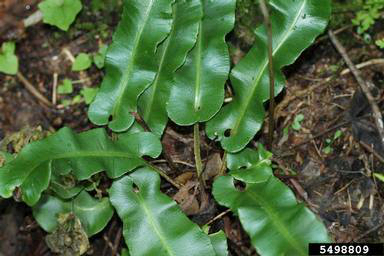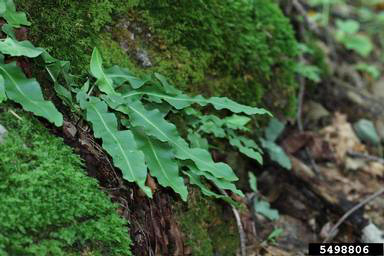Hart’s Tongue Fern, Asplenium scolopendrium L. var. americanum
By Joyce Tuharsky, WORC Member
The Niagara Escarpment is a limestone ridge that stretches in a huge arc from New York through Ontario, upper Michigan, Wisconsin, and into Illinois. It was formed from lime mud deposited from corals on an ancient sea floor 430 million years ago. The ridge that remains today is the result of uplift, weathering, and erosion. The Niagara Escarpment supports a unique forest ecosystem that is home to many rare and threatened plant species. One of these rare species is Hart’s tongue fern.

Unlike most ferns, the edges of Hart’s tongue fern fronds are smooth, not serrated. These large, wavy leaves are 12 to 24 inches long, upright, arching, and leathery in texture. Like other ferns, the fronds unroll vertically, making it a sight to see! One writer describes the leaves as looking like “unwinding fruit roll candy.” As a fern, Hart’s tongue is a bryophyte which means it reproduces asexually via the dispersal of spores rather than flowers/seeds. The spores are arranged on the underside of each leaf frond.
Hart’s tongue fern is a slow-growing, evergreen perennial. The large, glossy green leaves can look out-of-place in northern forests, especially against snow in the winter. However, snow pack seems to aid the plants’ vigor. During years of low snow pack, the plants have trouble retaining enough moisture. Hart’s tongue fern does prefer damp, shady places with high humidity and does not like direct sunlight. Harsh sun rays can burn the leaves.

Hart’s tongue is epipetric (grows on rocks) and is found in rock crevices, on moist boulders, ledges, and north facing slopes. It likes mossy places, needing just a few inches of rich humus to grow. It grows in close association with dolomitic limestone that is high in magnesium.
This species, Asplenium scolopendrium, is actually widespread world-wide, found on limestone outcroppings in the UK and Europe, eastern Asia, and Japan. But there are morphological distinctions between our North American variety and other populations. For example, the European Hart’s tongue plants are diploid (having two complete sets of chromosomes), while the North American plants are tetraploid (having four complete sets of chromosomes). Because of such differences, botanists consider the North American population as a distinct variety. (Four sets of chromosomes!? —Yes, having more than two sets of chromosomes in the cell nucleus is quite common in plants, including broccoli, wheat, and kiwi.)
The North America variety of Hart’s tongue fern is relatively sparse and listed as threatened by the U.S Fish and Wildlife Service. It is found in a couple counties in the eastern Upper Peninsula of Michigan within the Niagara escarpment (and within the Hiawatha National Forest) and in a few isolated locations in New York, Alabama (karst cave entrances), and Tennessee. It is abundant locally on the Bruce Peninsula on the eastern side of Lake Huron in Ontario, again within the Niagara escarpment.
Surprisingly, Hart’s tongue fern can be purchased over the internet, but it is unclear what varieties are being offered. They are unlikely to be the North American variety, since those plants are rare and protected. Anyway, they are very difficult to cultivate due to their unique growing requirements.
However, if one day, while traipsing within the Niagara Escarpment, you happen across Hart’s tongue fern…. ENJOY!!! …. but Do Not Disturb.
Photos by Rob Routledge, Sault College, Bugwood.org
American Hart’s Tongue Fern (usda.gov)
American Heart’s Tongue Fern — In Defense of Plants
Michigan Nature Magazine – Issue Winter 2022
